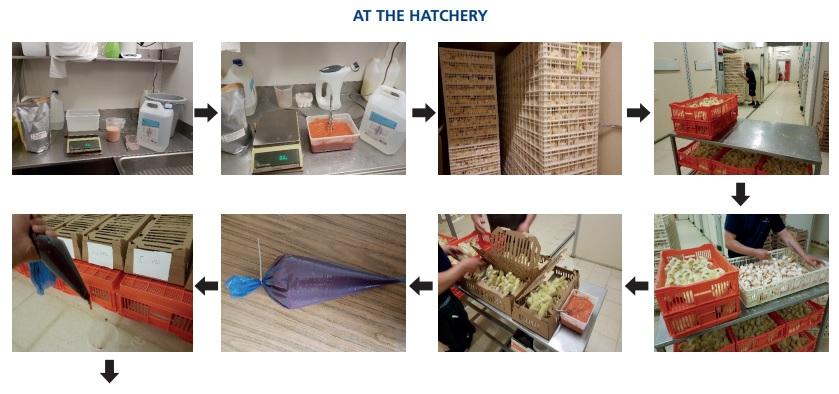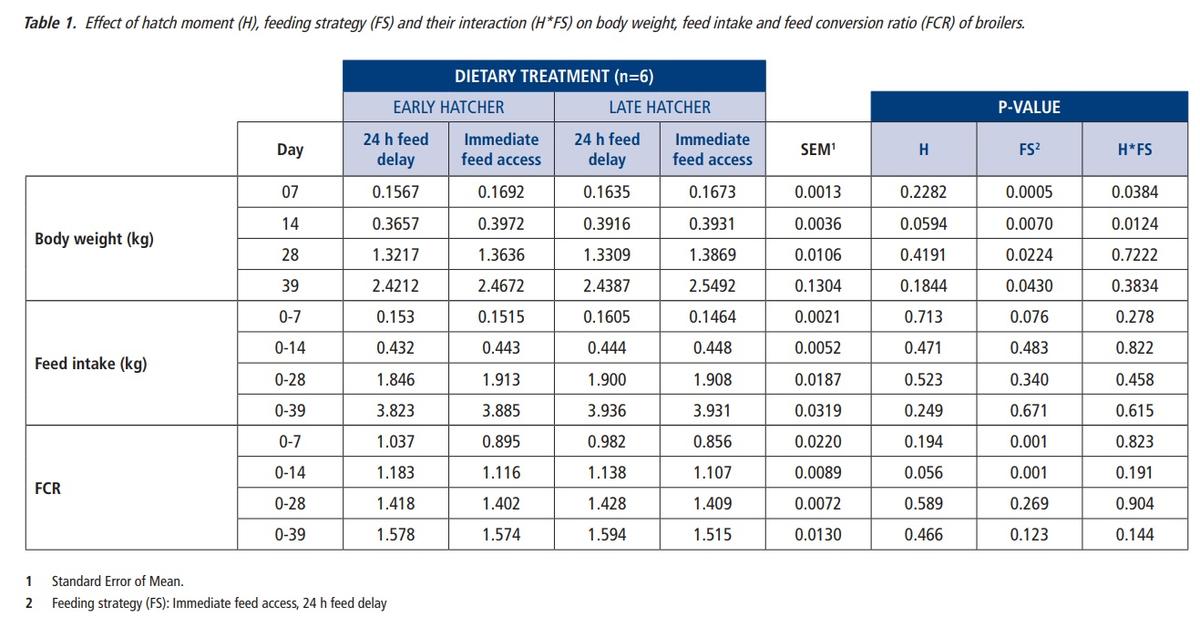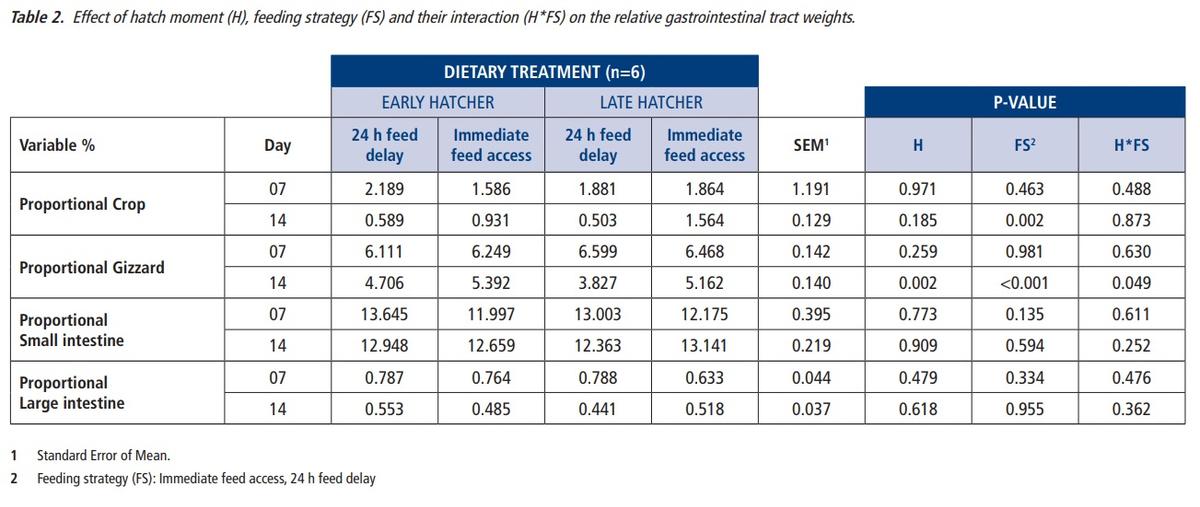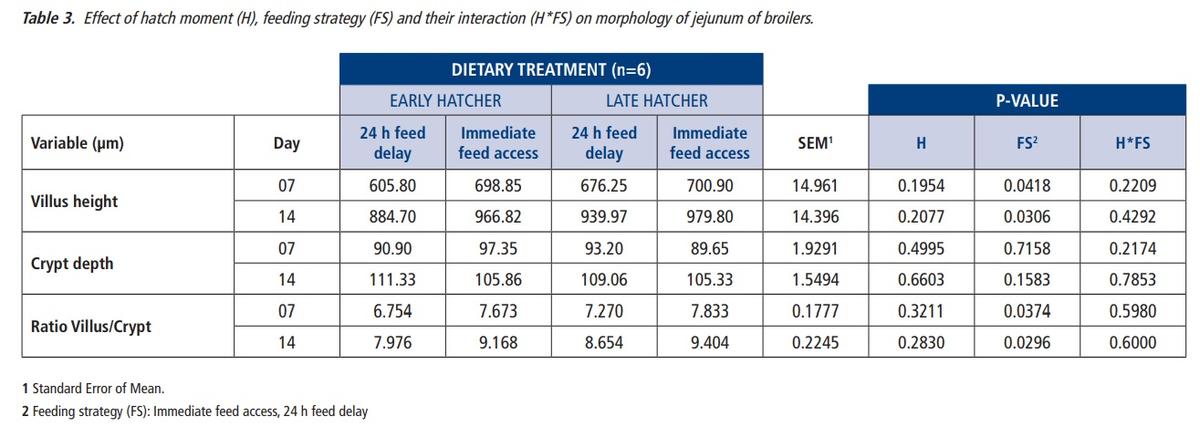Effects of moment of hatch and early feed access with Vitalite Energy Chick on performance and histology of commercial broilers
Published: September 17, 2018
By: Alireza Khadem*, †, 1, Jamal Al-Saifi*, Ben Letor*, Stephan Bauwens*, Jirka van Belle*, Markella Al-Saifi* and Milena Sevastiyanova*
* Innovad NV/SA, Cogels Osylei 33, 2600 Berchem, Belgium
† Laboratory of Animal Nutrition, Faculty of Veterinary Medicine, Ghent University, Heidestraat 19, 9820 Merelbeke, Belgium. 1 Corresponding Author: Alireza Khadem, e-mail: A.Khadem@innovad-global.com
Introduction
The neonatal period is a time when the chick requires special management and nutrition
Provide good environmental and nutritional conditions for day-old chicks are crucial for obtaining the full performance potential of the chicks later in life and maintaining profitable business for producers. The neonatal chicks remain approximately 24-48 h without feed and water after removal from the hatchery until placement in the farm. This gap between hatching time and access to feed is due to hatchery handling and transport processing. Despite the advances in transportation (truck, plane, or train), 1-day-old chick still may be transported for extended periods under suboptimal environmental conditions. This may cause stress and adversely affect chick development. For instance, dehydration has been reported to be a problem in newly hatched chicks transported for long periods. Chick mortality occurs mostly during the first week of grow-out period due to the combined stress of post-hatch handling in hatcheries, transportation, and poor adaptation to grow-out conditions. There is a relationship between early mortality and late mortality. Flocks that lost the most birds early, tended to lose the most birds late. Furthermore, incubation of chicken eggs takes about 21 days. Hatching eggs are commonly incubated for 17 to 18 d in setters. On embryonic d 19, candled eggs are transferred to hatcher for the last 3 to 4 d of incubation. In practice, hatching occurs over a 12 to 24 h period and chicks are removed from the hatchers only when most of the chicks have hatched and cleared the shell. Thus, early hatched chicks have stayed longer in hatcher, compared to chicks that emerge from the egg later in the hatching period. Following removal from the hatcher, subsequent processing and operations, such as sexing, vaccination, and transportation are carried out, before they are placed on farms which can then require an additional holding period of up to 12 h. During this time, feed and water may not be available for the chicks, which has been shown to negatively affect growth parameters and lead to suboptimal gut and immune and mucosal/villus development. Layer chicks with 48 h delayed feed access had a lower BW and decreased serum glucose, total protein and triglycerides concentration up to 56 days (Gaglo-Disse et al., 2010). Li et al., 2007 reported that newly hatched broiler chicks subjected to feed restriction had lower BW and lateral gastrocnemius weight accompanied by reduced serum hormone levels and changes of mRNA expression for growth-related genes in muscle. Early access to feed and water after hatch improves the initiation of growth in day old chicks and this growth promoting effect lasts until market age in poultry. Therefore, the aim of the present study was to investigate the effects of hatching time, combined with immediate and delay in feed access of 24 h on growth performance and gut morphology up to day 39.
Materials and methods
Animals, housing and diets
A total of 1700 eggs produced by a commercial flock of Ross 308 breeders were obtained from a local hatchery (VervaekeBelavi NV, Tielt, Belgium). All eggs were set in a forced-draft incubator at specific dry bulb temperature of 37.6 °C and wet bulb temperature of 29 °C. The eggs were turned every hour until day 18 of incubation, when the eggs will be candled and those with evidence of living embryos will be transferred from turning trays to hatching baskets. Between 480 and 504 h of incubation, the eggs were checked and hatched chicks were collected in the morning and in the afternoon and classified as early (in the morning) and late (in the afternoon) hatchers. Newly hatched chicks were evenly divided into immediate feed access (24 h with Vitalite Energy Chick on bottom of chickbox and on top of the feed at farm) and 24 h feed delay groups (24 h without Vitalite Energy Chick) forthwith after removing from the incubator. Vitalite Energy Chick is hydrating gel with highly digestible ingredients for immediate nutrition of newly-hatched chicks (Innovad®, Belgium). In the current study eggs were obtained from the single breeder flock, produced on the same day of lay, stored in one storage room and incubated simultaneously in the same single stage incubator. On arrival, One-day old broiler chicks were housed in 24 pens. Continuous lighting was provided throughout the experiment. The temperature at arrival was 32°C. Ambient temperatures were gradually decreased. The trial was consisted of 4 treatments with 6 replicates (pens) per treatment. Replicates (pens) have 23 broilers each. Commercial starter and grower and finisher diets were offered to the broilers from 1 to 14d of age and from 14 to 28d and 28 to 39d of age. Conditions at experimental farms are often too optimal to detect any effect, because of the absence of any challenge. In order to provide a challenge, in the present experiment, no coccidiostats were used in any of the experimental diets. Feed and water were provided ad libitum throughout the experiment.


Growth parameters and body composition
Body weight (BW) and feed intake (FI) were recorded pen-wise and feed conversion ratio (FCR) was calculated on day 7, 14, 28 and 39. FI was corrected for mortality, which was recorded on a daily basis. Weights of the crop, gizzard, small intestine, large intestine and the remainder of the body were recorded at day 7, 14 from 24 chicks (one bird per pen).
Gastrointestinal Morphology
For histological analysis and measurements of villus height and crypt depth, tissue samples of the intestine (mid jejunum) were taken, immersed in formalin (1%), fixed in Bouin’s solution for 24 h, and embedded in paraffin wax until use. Sections of 4 µm were cut using a microtome (Microm; Prosan, Merelbeke, Belgium). After deparaffinisation, the sections were rehydrated in isopropylene (5 min), 95% alcohol (v/v) (5 min), and 50% alcohol (5min) and stained with haematoxylin and eosin. Villus length and crypt depth in the jejunum were randomly measured in 3 villi per section using an Olympus BX61 Digital Camera DP50 (Olympus NV, Aartselaar, Belgium).
Statistical analysis
In this study, the effects of hatch moment within a 12-h hatch window and feed access after hatch were studied using a 2 × 2 factorial design. Treatments were two feeding strategies: immediate access to the feed (with Vitalite Energy Chick) and with 24 h delay access to the feed and two hatch moments, early and late hatchers. Statistical analysis was performed with SAS for Windows (version 9·4; SAS Institute, Inc.). The pen was considered the experimental unit for the measurements of BW, FI and FCR. For histology and digestive tract weight, individual chicks were considered the experimental unit. All data were checked for outliers and normality of the residuals. Normality of the sample distribution was assessed with the Kolmogorov– Smirnov test. The level of statistical significance will be set at P < 0.05.
Results
Body weight (BW), feed intake(FI) and feed conversion ratio(FCR)
The two hatch groups (early and late hatchers) had similar BW, FI and FCR on day 7, 14, 28 and 39 (P > 0.05) (Table 1). Early feeding after hatch with vitalite energy chick significantly increased the body weight of the broilers at all time points (7, 14, 28 and 39 d) (P<0.05). The interaction of hatch moments and early feed access on body weight was significant on day 7 and14 (P = 0.0384 and P= 0.0124 respectively), where increase in body weight was higher in early hatch chicks compared to the late hatch group. Early feeding with vitalite energy chick significantly improved the FCR on day 7 and 14 (P = 0.001 and P = 0.001 respectively), but had no effects on day 28 and 39 (P > 0.05). Feed intake was not affected by hatching time, early feed access and their interaction (P > 0.05) at all time points (Table 1).
Proportional digestive tract weights
The hatching time and immediate feed access did not affect the proportional digestive tract weight (g/kg body weight) on day 7 (P > 0.05). On day 14, early feeding with vitalite energy chick increased the proportional crop and gizzard weight (P = 0.002 and P<0.001, respectively). Moreover, the interaction between hatching time and feeding status on gizzard weight was significant on day 14 (P = 0.049) (Table 2).
Gut Morphology
Early feeding with vitalite energy chick significantly increased villus height and villus height to crypt depth ratio compared to delayed feed access without vitalite on day 7 and 14. Crypt depth was affected neither by hatch moments nor feed strategies (P > 0.05) (Table 3).



Discussion
Immediate feed access after hatch with vitalite energy chick resulted in higher BW and FCR compared with delayed fed access. A lower BW might be explained by impaired intestinal development, which is a direct consequence of delayed feed access as demonstrated by Noy et al., (2001). Impaired intestinal development has been shown by a lowered relative weight of the intestinal tract, shortened villus height and villus height crypt depth ratio. A long period of feed withdrawal may cause a permanent impairment of growth from which chickens do not recover by means of compensatory growth and performance. In the current experiment, chickens were indeed not capable to recover from delayed feed access for 24 h, although differences became smaller and non-significant from 14 days onwards. In the current experiment, the partial compensatory growth was reflected by chickens with delayed feed access having a same FCR throughout the experimental period than those with direct feed access. Although delayed feed access group had lower BW compared to the immediate feed access. Furthermore, significant interactions were found for BW at days 7 and 14, between moment of hatch and feed access. This was caused by differences between immediate and delayed fed chickens that early hatched chicks had more increase in BW compare to late hatch chicks when the received feed immediately after hatch.
In conclusion, delayed feed access for day old chicks resulted in lower growth performance compared with direct access. It can be suggested that the current period of delayed feed access resulted in a permanent impairment of the chickens’ growth capacity.
Early feeding with Vitalite Energy Chick after hatch resulted in higher BW and lower FCR. Feeding a hydrating gel with highly digestible ingredients tends to be most effective for delayed fed broiler chickens by means of higher growth performance as well as on gastrointestinal development.
References
Gaglo-Disse A, Tona K, Aliou S, Debonne M, Aklikokou K, Gbeassor M and Decuypere E 2010. Effect of delayed feed access on production and blood parameters of layer-type chicks. Acta Veterinaria Hungarica 58, 211–219.
Li Y, Yuan L, Yang X, Ni Y, Xia D, Barth S, Grossmann R and Zhao RQ 2007. Effect of early feed restriction on myofibre types and expression of growth-related genes in the gastrocnemius muscle of crossbred broiler chickens. The British Journal of Nutrition 98, 310–319.
Noy Y and Sklan D 2001. Yolk and exogenous feed utilization in the posthatch chick. Poultry Science 80, 1490–1495.
Related topics:
Authors:
Innovad
Innovad
Innovad
Innovad
Innovad
Show more
Influencers who recommended :
Talaat Mostafa El-SheikhRecommend
Comment
Share
11 de octubre de 2018
Good work done. Could you please send me a brochure of the product?
My e-mail address is as shown below.
davidquartey61@gmail.com
Thanks
Recommend
Reply

Would you like to discuss another topic? Create a new post to engage with experts in the community.












.jpg&w=3840&q=75)